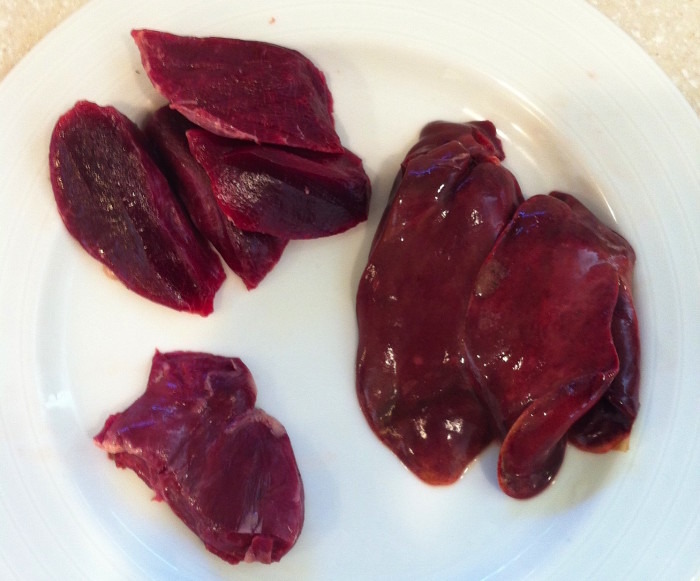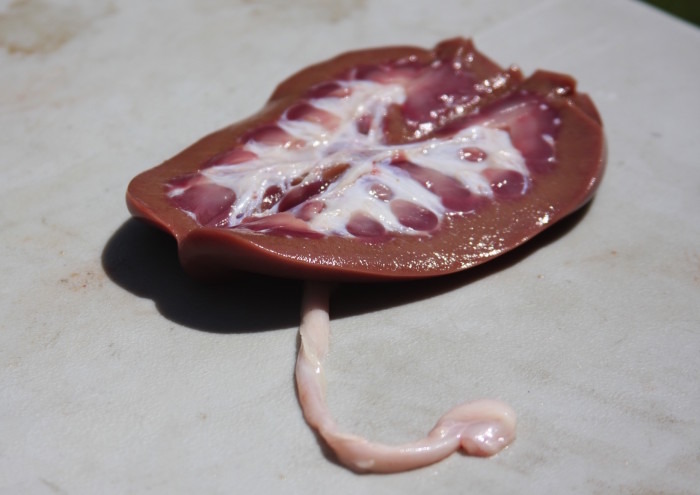A Guide To Eating Offal, The Most Overlooked Cuts Of Meat
Food Republic's column Ask Your Butcher seeks to answer FAQs in the world of butchery. Ethically minded butcher Bryan Mayer — former founder and co-owner of Philadelphia's Kensington Quarters, a full-service restaurant, bar, butcher shop and classroom — will tackle a pressing issue facing both meat buyers and home cooks in each column. Next up, Mayer explores eating offal, which he considers to be frequently overlooked.
If you work behind a meat counter, it's inevitable that you'll get asked some variation of the following a few times per week: "I see what you have in the case, and it all looks great, but do you have anything interesting? Something that I haven't tried before?"
Given that we're big supporters of local agriculture here, you can be sure we're not squirreling away some kangaroo loin or alligator stew cubes in the walk-in — not that there's anything wrong with either of those choices. So after we go down the list of some usual suspects: bavette, merlot, trench, spider, braison and anything off a goat, I'll pop into the walk-in one more time and walk out with some of the most overlooked parts on any animal (in our culture): organ meat, known in food circles as offal.
We love to talk about how whole-animal-centric we've become. Reverence for the whole beast, snout to tail, everything but the moo, oink or bahhh. The fact is, however, that we eat very little offal. Not only do we eat very little offal, but we cook with almost no animal fats and don't make our own stock. To quantify that for you, if we were to take a beef carcass and butcher it down to all its "usable" parts, fat and bone would make up roughly 20 percent and 15 percent, respectively, of the carcass weight (offal is weighted separately as it is removed from most carcasses). What's left is a mix of trim (most often used for ground beef) and various steaks and roasts. And here's another number for you: That rib eye you love so much accounts for about three percent of the animal. Strips and tenderloins account for even less. That's right, folks, cattle aren't made of steaks! Keep in mind that these numbers can fluctuate based on season, breed and diet, but they give a fairly accurate picture of what comes off a beef carcass.
Clearly, we need to pay attention to more of the animal. Potatoes roasted in pork fat add a unique depth of flavor. Fry your chicken in beef tallow and — besides flavor — you've got an incredibly heat-stable fat, unlike a lot of vegetable oils. Roast those bones after you've cooked a chicken for a hearty stock that will save you from running to the grocery store to grab a quart of chicken-flavored sodium-bomb water for your risotto.
But let's up your game a bit and start eating more offal. Organ meats from grass-fed, fully pastured animals are some of the most nutrient-rich foods you can eat. I can't stress enough that these need to be fully pastured, non-feedlot animals. Their unnatural diets, usage of veterinary drugs and living conditions make for unhealthy organs. The same goes for their meat.
Ever wonder why predatory animals go right for the offal, especially the liver? That is because offal is incredibly nutritious and loaded with minerals, vitamins and amino acids that are vital to our health. Liver is one of nature's most concentrated sources of vitamin A. Heart contains an incredibly unique mix of nutrients that boost stamina and endurance and build muscle. It's also rich in vitamin B12. And kidneys, while being incredibly lean (if you trim off all that delicious fat) and also loaded with B12, come packed with riboflavin and iron.
Okay, so with all this nutritional content, you're going to have enough energy to run a half marathon as well as great-looking skin, but you still might be thinking, "There's no way I'm eating heart!" Here are a few tips to make the transition a bit more palatable for the uninitiated.

Heart
I like to tell my less adventurous friends that heart is a muscle and to not talk about its organ-ness. It's a bit of a stretch as it is an organ that is made up of muscle tissue (and other tissue), but I digress. A few years ago I spent the summer cooking and butchering with a friend from Peru. Among the lessons I was taught about Peru's multicultural history and its place in fusion cuisine, I was introduced to anticuchos, my go-to dish for the newly initiated. It's incredibly easy to prepare and cooks in minutes. You'll want to marinate it overnight in a mix of spices, peppers, and, of course, an acid like vinegar. This will help break down the muscle and tenderize it. Skewer it, place it for three or four minutes on your grill and what you'll have is a meaty, flavorful cut that will erase the words "stew cubes" from your lexicon the next time someone says "kabobs." Hottip: If you're still a bit squeamish, have your butcher do the cutting for you. You will want to slice the heart into thinnish pieces so that the acid can penetrate quicker while it marinates. Those thicker chunks are better for braises, or — even better — grind some into your burger for what I call the "corazón blend"!

Liver
Liver is eaten all over the world using many preparations, and whether you enjoy it fried, whipped into a mousse or raw as sashimi, you're getting an incredible amount of nutrients and flavor. Not quite ready to tackle a plate of beef liver with some fava beans and a Chianti? A mousse or pâté made with chicken livers is a great springboard into all things liver. You'll need little more than liver, spice and fats like cream and butter before Chris Cosentino is calling you to be his next charcutier. If you want to go the simple liver-and-onions route right out of the gate, make sure to give the livers a soak in an acid or milk to reduce the metallic taste you might not be accustomed to.

Kidneys
There's a joke in the butchers' world that goes, "How do you cook a kidney..." We'll leave the answer to your Googling skills, but I will say — despite this disparaging joke — that kidneys are a tasty cut and take on flavors easily. The freshest and best kidneys are plump and free of odors and discoloration. Again, like other organ meats, kidneys benefit from a soak; either in salty water or an acid is fine. One of my favorite preparations is to sauté with butter and herbs and serve atop a piece of crusty bread. An easier way for the offal-timid is savory pie. Seal diced meat and kidney — along with onions and gravy — in a flaky pie, and you'll be able to sneak it past the pickiest of eaters.
If you're looking to get a bit more adventurous, there are always things like brain, spleen, tripe and even lungs, although those will have to wait for your next vacation abroad as the USDA does not allow their sale domestically. Again, you'll want to buy these items extremely fresh or frozen, as they are highly perishable, and only from grass-fed, fully pastured animals.
Still not convinced? While technically not offal — though some do consist mostly of skin — tail can be a great intermediary. And I defy anyone to turn down a bowl of my Filipino partner's kare-kare.

